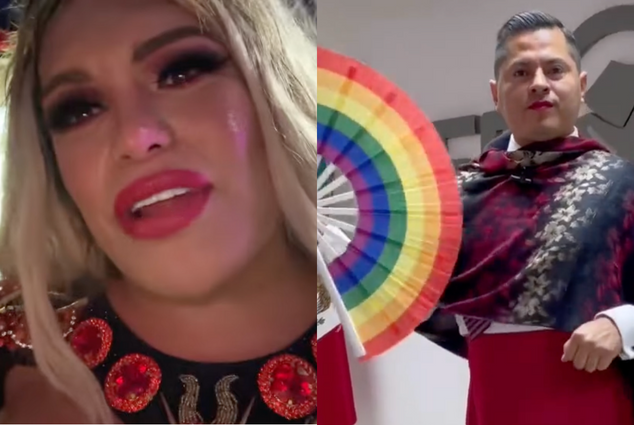In August 2023, Wendy Guevara, an influencer who gained fame from a viral video posted to social networks, became the first transgender woman to win a reality show on Mexican television. Press in that country covered the news with articles that referred to her with feminine pronouns, without misgendering.
But a very different situation occurred three months later, with the murder of Jesús Ociel Baena. Baena was the first nonbinary person (that is, whose gender identity does not correspond to either male or female) to serve as magistrate in Mexico. Baena had managed to have their title officially designated with nonbinary language. They also used the neutral pronoun “elle” and their official documents, such as passport, birth certificate, and voter identification, also attested to their nonbinary identity.
Still, in their coverage of Baena’s murder, many news outlets referred to Baena with masculine pronouns, or put their title in quote marks or in italic letters. Few media outlets used the nonbinary language that Baena had requested.

Coverage of trans influencer Wendy Guevara (left) and magistrate Ociel Baena (right) in the Mexican press suggests that the media do not have the tools to reflect the realities of nonbinary people. (Photo: Screenshots from YouTube and TikTok)
The difference in how media covered Guevara and Baena suggests that many Mexican outlets do not have the tools and protocols to reflect the realities of nonbinary people in their journalistic products, according to specialists and journalists who closely followed coverage of Baena’s murder.
“I often come across media that, from a very purist point of view of language, hesitate to respect, even if you share your pronouns. They see everything as in the name of language, because language is what matters to them,” Alex Orué, assistant manager of global programming for the LGBTQ+ support and empowerment organization It Gets Better, told LatAm Journalism Review (LJR). “Spanish is a language very loaded with gender issues. When we present ourselves as a nonbinary community, which refers to any spectrum that departs from the traditional binary, Spanish does not adjust to our realities.”
According to the Royal Spanish Academy (RAE, for its acronym in Spanish), the Spanish language only has masculine and feminine grammatical genders, while the neuter gender does not exist to refer to animated beings. These guidelines have been adopted in media style manuals, so journalists find themselves in a dilemma when they must refer to people whose gender identity is outside the male and female binary.
“Yes, the problem is greater for nonbinary people because they completely present us with a scenario that we don’t know,” Paulina Chavira, journalist and linguistic media advisor, told LJR. “[In Spanish] you have to make agreements in feminine and masculine, but when I have to talk about a person who does not identify with either of the two, or not only with those two, that is when we say 'and now, what do I do?’ That’s when we run out of tools.”
But for nonbinary people, this media resistance can feel like a lack of empathy and even reinforce stigmas or re-victimization. For Orué, the nonbinary population is practically invisible in the media. And the media, by resisting the use of inclusive language, encourage this invisibility and contribute to amplifying biases.
“Maybe it's not enbyphobia [term used to name discrimination against nonbinary people] as such, but the damage is in not having this empathy to say 'I don't know about this topic, why don't I ask nonbinary people what the right way is?'” Orué said. “So it is a revictimization left and right that affects nonbinary people in a very particular way, because of how and what language is used.”
Journalist Erika Rosete, one of the three coordinators of “Americanas,” the El País América newsletter with content that has a gender perspective, covered Baena’s murder. The Spanish publication was one of the media outlets criticized for the language it used in its articles about the case.
Rosete said that, while reporting on the crime in Aguascalientes, she encountered the concern of nonbinary young people who saw in the magistrate a hope that their identity would be legally recognized in a state that has the fifth highest percentage of LGBTQ+ people in Mexico, according to the National Institute of Statistics and Geography.
“I realized that if you start from how you name a person and if you start violating those first things that many people believe are totally superficial and unimportant, it is much easier for you as a human being and citizen to start violating all the other codes that allow you to respect someone else,” Rosete told LJR, speaking from her personal point of view. “All this has an impact on young people who are in an identity limbo in which they do not feel part of anything, and I think that language helps a little to recognize someone's identity.”
Rosete, who received some criticism towards El País on her social networks, admitted that she hesitated about how to use Baena's pronouns when writing her articles.
She did not doubt it out of principle, but because as a graduate of the Masters of Journalism program taught by El País and the Autonomous University of Madrid, she knew first-hand the importance that the Spanish newspaper places on its style guide.

El País newspaper chose to use Baena's title with quotation marks in its headlines. (Photo: Screenshot of El País)
“Our style book does not consider nonbinary language [...]. The decisions made about headlines always take into account the context, but also the style book,” she said. “That is not for the journalist to decide, and that is something that I wanted to explain on social networks [...]. There are headlines that are decided by editors and newsroom heads. In this case, that's how it was."
Rosete said that on the day of Baena's murder there was a discussion in the El País newsroom in Mexico City that extended to the newspaper's headquarters in Madrid, because the events conflicted with the style manual. That discussion, the journalist said, lasted an entire day and led to the headline of her story being changed several times.
In the end, El País decided to refer to the victim with masculine pronouns and chose to use the title of magistrade in quotes in its headlines and in italic letters in the body of the articles.
Rosete said she sees this discussion and the debate sparked on social networks about Baena's pronouns as opportunities to reflect on how open journalists are to listening to people and the new ways in which they relate.
“It is as if this part of society that we media cannot see or take into account is knocking on our door telling us 'the world is changing and the way we are describing it with words is changing,'” she said. “I like to think that the natural flow is that these conversations take place between newsrooms, between speakers, and then decisions are made. I hope that the next editions of the style book [of El País] consider some variant in which [the nonbinary population] is reflected.”
As a result of the debate, El País called on linguistics advisor Paulina Chavira to write a column on the topic. She wrote about the importance of recognizing the identity of nonbinary people through language. In addition, the El País México podcast “Al Habla…” with journalist Gabriela Warkentin, dedicated an episode to the legacy that Baena left in this regard.
Rosete herself took the initiative to write the opinion column “The magistrade and the right to name people for dignity,” about how instructive the coverage of the case had been for her. That column, she said, was a way of responding from an individual point of view, and not as a collaborator of El País, to the criticism she received through social networks.
“It's a little frustrating to have that dilemma because you know how the machinery [of a newsroom] works and you know that these institutions have their reasons,” she said. “[The column] was a way of explaining ‘I understand what you are telling me, I respect it, but I also have to follow certain rules in my newsroom while this changes,’ and I’m sure it will change.”
The newspaper La Jornada is another Mexican media outlet in which the use of inclusive language is decided in editorial meetings and on a case-by-case basis, Juan Carlos Rosas, one of the newspaper's editors, told LJR. In its coverage of Baena's murder, La Jornada respected the title magistrade, although it used male pronouns.
However, La Jornada has used inclusive language in previous coverage, as in the case of groups fighting for women's rights that describe themselves as “colectivas.” For the RAE, the -as ending does not exist for that word as a noun.

Journalist Erika Rosete wrote a column about how instructive the coverage of the Ociel Baena case had been for her in terms of the use of inclusive language. (Photo: Screenshot)
“A newspaper has to report what is happening and how people name themselves. But sometimes some proofreaders say 'no, because that is not normalized yet,'" said Rosas, who clarified this is his personal point of view. “I think it will change at some point, but we are still in the transition. […] People are already talking that way, well we have to adapt because if not we are going to be outside of that reality.”
Rosas said there is also some generational resistance inside the newsroom when it comes to the use of inclusive language.
However, for journalist Lucía Solis Reymer, co-founder of the Network for Diversity in Latin American Journalism, it is not about challenging what the rules of Spanish or style manuals say, but rather about seeing inclusive language as an alternative resource to describe a part of reality.
“We know where those guidelines come from and the reasons why [nonbinary language] is not accepted. Many times we are not in a position to disobey those rules, ultimately it is a job,” Solis Reymer told LJR. "But we can propose using much more inclusive expressions that are not just the use of 'x' or 'e.’ There are many resources, guides, manuals on the internet from reliable organizations where they recommend other types of expressions to use if it is not yet allowed in your media outlet or in your organization.”
When she was in charge of the style guide of The New York Times en Español, Chavira said she used to be a firm defender of the RAE standards at the media outlet –until 2019, when the newspaper's team in Mexico had to translate an article from the New York newsroom about the person of Latinx origin in the United States who asked their state representatives for a gender-neutral option on driver's licenses.
It was up to Chavira to decide what to do. She consulted colleagues about the best option to translate the article accurately without violating Spanish rules. Some, she said, recommended finding a way to turn the problem around to avoid using pronouns that do not exist in the language.
“If the angle of the article is that it is about a nonbinary person, there is no way I can avoid referring to this person at least with the pronoun they are asking for,” she said. “They gave me several recommendations that were more in line with English, because there had already been this debate in English. Then I came across the 'elle' option. I said 'I think it's the closest, and it's already being used in other places.'”
Finally, El Times en Español used the pronoun “elle” to translate “they,” a pronoun generally used by the nonbinary population in English-speaking countries.
“From then on, when we had articles where ‘they’ was used in the singular in English, we did the translation using ‘elle,’” she said. “There it became clear to me that we needed to learn to use inclusive language.”
Chavira said that using inclusive language in journalism does not mean going against the proper use of Spanish. Journalists, she said, use words and constructions all the time that do not officially exist in Spanish. Such was the case of “COVID,” a term that the World Health Organization (WHO) introduced on Feb. 11, 2020 to officially name the acute respiratory syndrome that by then was beginning to dominate the news.
The WHO stressed the importance of using the new term to avoid stigmatization, such as those that alluded to the reported origin of the virus in Wuhan, China, and to have a standard word for future outbreaks of diseases caused by a coronavirus. The media adopted it without question, while the RAE endorsed it until several months later.
“We made COVID an ambiguous noun that can be used both feminine and masculine,” Chavira said. “The same thing is happening with inclusive language: we have a reality that must be named, avoiding stigmatization, avoiding misgendering. So there are these new alternatives.”
Chavira said that the words formed from nonbinary language in Spanish are well-formed words that comply with the grammar of the language, even if they are not part of the dictionary.

Linguistic advisor and journalist Paulina Chavira said that inclusive language is an alternative to name a reality avoiding stigmatization or misgendering. (Photo: Paulina Chavira's Twitter)
But she said the use of nonbinary language is not a question of linguistics, but of respect. And, in the case of journalists, it is also a question of precision.
For Solís Reymer, the use of this type of language is also a matter of respect for plurality, which she considers one of the fundamental pillars of journalism.
“By including people who have not traditionally or historically been included, what we do is enrich journalism, not only about people but also about more diverse experiences,” Solís Reymer said. “And that includes the pronouns that nonbinary people use, the nouns, certain expressions, even adjectives.”
Mexico is the second most violent country in Latin America for the LGBTQ+ population only after Brazil, according to the National Observatory of Hate Crimes against LGBT People. In this context, the discussion about the use of inclusive language in journalism should start from considering the human rights of that population, Rosete said.
“More than the ideology of the media outlet or the [Royal] Academy, what I think should be upheld is respect for human rights,” she said. “When I write an article, I don't expect everyone to like it, because it is not the function of journalism. But I also don't like to realize that, because of a word or something that I didn't know how to deal with as a professional, I am hurting someone's sensitivity regarding their human rights.”